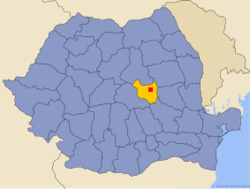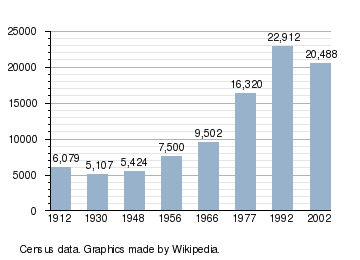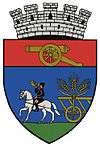Târgu Secuiesc
| Târgu Secuiesc Kézdivásárhely | |||
|---|---|---|---|
| Municipality | |||
|
| |||
| |||
 Location of Târgu Secuiesc | |||
| Coordinates: 45°59′49″N 26°8′26″E / 45.99694°N 26.14056°ECoordinates: 45°59′49″N 26°8′26″E / 45.99694°N 26.14056°E | |||
| Country |
| ||
| County | Covasna County | ||
| Status | Municipality | ||
| Government | |||
| • Mayor | Tibor Bokor, elected 2012 (UDMR) | ||
| Population (2011) | |||
| • Total | 18,491 | ||
| Ethnicity[1] | |||
| • Hungarians | 91.1% | ||
| • Romanians | 7.2% | ||
| Time zone | EET (UTC+2) | ||
| • Summer (DST) | EEST (UTC+3) | ||
Târgu Secuiesc (Romanian pronunciation: [ˌtɨrɡu sekuˈjesk]; Hungarian: Kézdivásárhely, Hungarian pronunciation: [ˈkeːzdivaːʃaːrhɛj]; German: Szekler Neumarkt; Latin: Neoforum Siculorum) is a city in Covasna County, Romania. It administers one village, Lunga (Nyujtód).
History
The town was first mentioned in 1407 as Torjawasara, meaning in Hungarian “Torja Market”. (Torja is the name of a stream nearby and is also the Hungarian name of the nearby village Turia.) Originally, the Hungarian name Kézdivásárhely was also used in Romanian in the form Chezdi-Oșorheiu, but this was altered to Tîrgu Secuiesc (now spelled Târgu Secuiesc) after the accession to Romania in 1920 under the Treaty of Trianon. The Hungarian native name means “Kézdi Market”, Kézdi being the name of a Székely “seat”, a historical administrative unit. Its status as a market town dates back to the Middle Ages. The city was taken over by Hungary during World War II, following the Second Vienna Award of August, 1940. Sovereignty was restored to Romania following the war.
Demographics
According to the 2011 census, the town had a population of 18,491. Of the residents for whom data were available, 91.1% were Székely Hungarians, 7.2% Romanians and 1.6% Roma. The historical demographic evolution is as follows:
Demographic change according to census data:

Education
Despite its relatively small size the town has a few notable high schools: Nagy Mózes, Bod Péter, Apor Péter and Gábor Áron, all bearing the names of important Székely historical personalities. Because of this, Târgu Secuiesc is considered the educational center of the north eastern part of the county.
Tourist attractions
- City center
- City center
 Cultural Center
Cultural Center
References
- ↑ (in Romanian) Populaţia stabilă după etnie - judeţe, municipii, oraşe, comune, National Institute of Statistics; accessed December 2, 2014
External links
| Wikimedia Commons has media related to Târgu Secuiesc. |
- Official site (in Hungarian) (in Romanian) (in English)
- Kézdivásárhely Centrum City Map
- Official site of the Kézdivásárhely Sportclub (KSE) (in Hungarian) (in English)
- Nagy Mózes High School
- Gábor Aron High School


